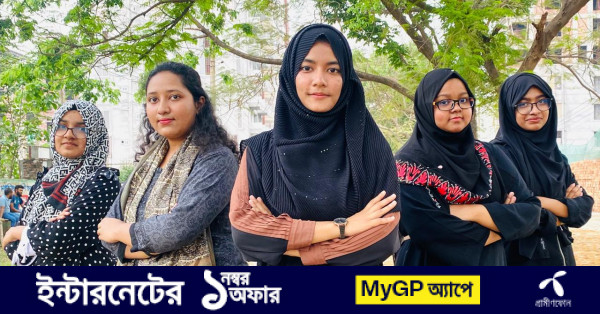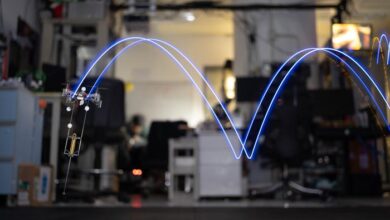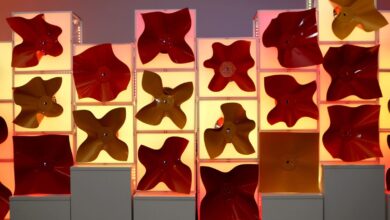Code Black: All-female robotics team makes a point with big win

An all-women robotics team, Team Code Black, defied stereotypes and made a powerful statement for all girls aspiring to contribute to STEM
There was a mix-up during the announcement of results of this year’s World Science, Environment, and Engineering Competition (WSEEC) in Jakarta, Indonesia, on Sunday.
The organisers announced the bronze and silver medal-winners under the Technology segment, leaving the Code Black team – the first all-female robotics team from Bangladesh – both anxious and hopeful for the gold. However, when the gold medal was announced, it wasn’t their name. The team’s spirits plummeted.
It turned out a little later that the results displayed were actually for another category: Energy and Engineering. When the Technology segment results were finally announced and Code Black was declared the gold medal winner, the team was overwhelmed with joy.
“We hugged each other and walked towards the stage like robots, noticing nothing around,” shared Jannatul Ferdous Fabin, a third-year Computer Science & Engineering student at BRAC University.
Fire events have become more prevalent in recent decades. The Bailey Road’s fire incident is one of the very recent and severe examples. The challenge is, a firefighter has to start with stopping the fire from the outside. He can’t get himself into the fire, but our robot ‘Prohori’ can. It gets into the fire, while vacuuming the smoke as much as possible, and attempts to stop the origin first
Fabin
It was a significant achievement especially for the youngest members, Saniea Islam Sara and Nosrat Jahan Nowrin, who attended an international competition for the first time. “I would have been happy even with a bronze,” said Sara.
Despite living in 2024, social stigma and stereotypical beliefs still pose a silent barrier to women’s advancement in STEM (Science, Technology, Engineering, and Mathematics) in Bangladesh. The notion that “only males suit this field” persists, hindering progress.
The team comprises five members. Fabin is the team lead. Nusrat Zahan Sinha served as the team manager, and Tahia Rahman was the project manager. The remaining two, Nowrin and Sara, are studying at Jatir Janak Bangabandhu Sheikh Mujibur Rahman Government College.
While Fabin, Sara, and Nowrin attended the final round in-person, Tahia and Sinha were connected virtually.
Code Black was established back in 2021. “The purpose was to create a safe and dedicated platform for female students to practise robotics and beyond”, Jannatul Ferdous Fabin shared with The Business Standard.
“Girls are often questioned by their parents and society and are discouraged to participate in STEM. Projects usually require teamwork all night, but girls are not allowed to stay outside their homes after evening. Therefore I thought of forming an all-female platform,” she added.
The team had to submit some documents representing their ideas and the robot’s configuration for the preliminary round. After being selected, they were invited for the final round in Jakarta, which took place between 13 to 17 May.
WSEEC is an annual multinational innovation competition encompassing General Science, Environment, and Engineering, with participants ranging from elementary to university levels.
Specifically, this competition includes fields such as Mathematics, Energy and Engineering, Physics, Natural Sciences, Social Sciences, Environment, and Technology. Team Code Black brought the gold, showcasing their project ‘Prohori’ in the Technology segment.
Project Prohori
Prohori is a rescue robot engineered for disaster response and search-and-rescue tasks. Simply put, its main feature is fire extinguishing. With cutting-edge image processing and AI, it can analyse visual data in real time, identify survivors, evaluate hazardous conditions, and navigate complex environments with unmatched precision.
It uses various sensors to locate survivors, assess hazardous conditions, and skillfully navigate complex environments. Moreover, Prohori is capable of making autonomous decisions to adapt to unforeseen challenges during rescue missions. The robot was designed taking inspiration from the book ‘Nakshi Kanthar Math’ by Jasimuddin.
“Fire events have become more prevalent in recent decades. The Bailey Road’s fire incident is one of the very recent and severe examples. The challenge is, a firefighter has to start with stopping the fire from the outside. He can’t get himself into the fire, but our robot ‘Prohori’ can. It gets into the fire, while vacuuming the smoke as much as possible, and attempts to stop the origin first,” said Fabin.
Its outer body is made of aluminium alloy and can bear 1260 degree Fahrenheit of temperature. A 360-degree rotating camera is attached to show real-time updates of the surroundings. Its ultrasonic sensor can detect obstacles forward as well. It can work eight hours at a stretch without any power cut.
The idea of Prohori was first developed back in 2019. It has gone through a few rounds of development with new features added each time. This is the fourth version of the robot and it took two months to complete.
Two members of the team, Fabin and Sinha, are students at BRAC University. Their institution provided huge support, both mentally and financially. The robot cost nearly Tk 4-5 lakhs, excluding the research and development cost, and it was partially funded by BRAC University.
Promoting women in STEM
Code Black has more than 50 general members across the country. They select active participants to form a team prior to each big event. Fabin shared that their members have a history of participating in various robotics and programming competitions.
Previously, they won the Gold Medal at the International Science and Innovation Fest 2022 in Bali, Indonesia, and the Bronze Medal at the World Robot Olympiad in both 2022 and 2019.
“Our main goal is to promote the advancement of women in STEM fields in Bangladesh by overcoming all obstacles. We regularly organise workshops and events to empower our members with practical training, encouraging their active participation in technology, robotics, artificial intelligence, and IoT,” said Nusrat Zahan Sinha.
Besides participating in international competitions, the team is actively engaged in developing agricultural tech products at their robotics research lab in Banasree, Rampura. Code Black is leading the way for girls in Bangladeshi robotics, proving at global competitions that girls can excel in STEM fields.
“The pros and cons of being an all-female team are a bit similar. The advantage is that we are getting acceptance. Female students across the country are showing interest to join us. Society has started to believe that we can do it too. However, we have to convince the guardians where we are going, what we are doing, how we would manage everything etc. So clearly, change is happening but still— way to go,” said Fabin.
“Then again, we often encounter negative and hate comments on social media for no reason, maybe for being all-women. Initially it got us really disappointed, but now we have learned to ignore them,” she added.
This year, WSEEC was organised by the Indonesian Young Scientist Association (IYSA) and took place at the Universitas Pancasila, Faculty of Pharmacy, Jakarta, Indonesia. 310 teams representing 18 countries participated in the competition. The teams appeared from Indonesia, the USA, China, Thailand, Mexico, Malaysia, and more.
“It was my first international competition too. The expectation was low but we achieved everything here. I can’t express in words how it felt when I saw our team’s name with the gold medal announcement. It feels amazing to bring glory to the country,” said Tahia Rahman.
When asked about their vision, Fabin said that they want to expand their activities more across the country and welcome more women to join their journey.
“Bangladeshi parents have a typical concept that their son will be an engineer and daughter a doctor. We want to break that stereotype. We aim to make them believe and dream of their daughter winning big in the science and technology arena. Because they really can,” she concluded.



